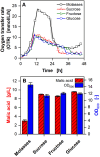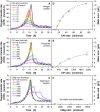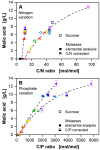Phosphate limitation enhances malic acid production on nitrogen-rich molasses with Ustilago trichophora
- PMID: 38961457
- PMCID: PMC11223335
- DOI: 10.1186/s13068-024-02543-z
Phosphate limitation enhances malic acid production on nitrogen-rich molasses with Ustilago trichophora
Abstract
Background: An important step in replacing petrochemical products with sustainable, cost-effective alternatives is the use of feedstocks other than, e.g., pure glucose in the fermentative production of platform chemicals. Ustilaginaceae offer the advantages of a wide substrate spectrum and naturally produce a versatile range of value-added compounds under nitrogen limitation. A promising candidate is the dicarboxylic acid malic acid, which may be applied as an acidulant in the food industry, a chelating agent in pharmaceuticals, or in biobased polymer production. However, fermentable residue streams from the food and agricultural industry with high nitrogen content, e.g., sugar beet molasses, are unsuited for processes with Ustilaginaceae, as they result in low product yields due to high biomass and low product formation.
Results: This study uncovers challenges in evaluating complex feedstock applicability for microbial production processes, highlighting the role of secondary substrate limitations, internal storage molecules, and incomplete assimilation of these substrates. A microliter-scale screening method with online monitoring of microbial respiration was developed using malic acid production with Ustilago trichophora on molasses as an application example. Investigation into nitrogen, phosphate, sulphate, and magnesium limitations on a defined minimal medium demonstrated successful malic acid production under nitrogen and phosphate limitation. Furthermore, a reduction of nitrogen and phosphate in the elemental composition of U. trichophora was revealed under the respective secondary substrate limitation. These adaptive changes in combination with the intricate metabolic response hinder mathematical prediction of product formation and make the presented screening methodology for complex feedstocks imperative. In the next step, the screening was transferred to a molasses-based complex medium. It was determined that the organism assimilated only 25% and 50% of the elemental nitrogen and phosphorus present in molasses, respectively. Due to the overall low content of bioavailable phosphorus in molasses, the replacement of the state-of-the-art nitrogen limitation was shown to increase malic acid production by 65%.
Conclusion: The identification of phosphate as a superior secondary substrate limitation for enhanced malic acid production opens up new opportunities for the effective utilization of molasses as a more sustainable and cost-effective substrate than, e.g., pure glucose for biobased platform chemical production.
Keywords: Ustilago trichophora; Alternative feedstock; Bioavailability; Bioeconomy; Internal phosphate storage; Malic acid; Molasses; Online monitoring; Phosphate limitation; Platform chemical.
© 2024. The Author(s).
Conflict of interest statement
The authors declare that they have no competing interests.
Figures




References
-
- Werpy T, Petersen G. Top value added chemicals from biomass Volume I Results of screening for potential candidates from sugars and synthesis gas. US Department of Energy. 2004. 10.2172/15008859.
-
- Kövilein A, Kubisch C, Cai L, Ochsenreither K. Malic acid production from renewables: a review. J Chem Technol Biotechnol. 2020;95:513–526. doi: 10.1002/jctb.6269. - DOI
-
- Goldberg I, Rokem JS, Pines O. Organic acids: old metabolites, new themes. J Chem Technol Biotechnol. 2006;81:1601–1611. doi: 10.1002/jctb.1590. - DOI
Grants and funding
- 031B1135B / 031B1135BX/Bundesministerium für Bildung und Forschung
- 031B1135B / 031B1135BX/Bundesministerium für Bildung und Forschung
- 031B1135B / 031B1135BX/Bundesministerium für Bildung und Forschung
- 031B1135B / 031B1135BX/Bundesministerium für Bildung und Forschung
- 031B1135B / 031B1135BX/Bundesministerium für Bildung und Forschung
LinkOut - more resources
Full Text Sources
